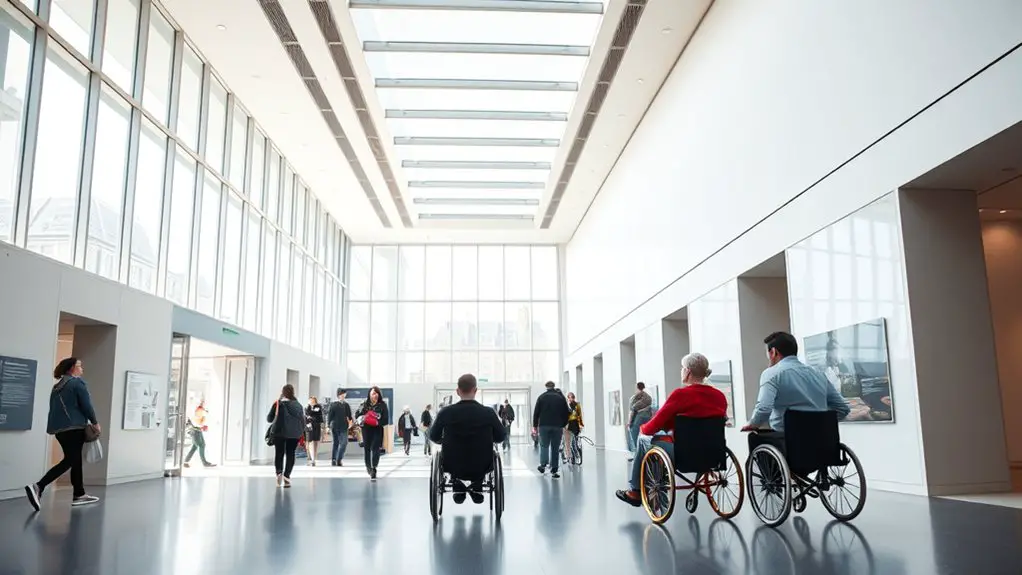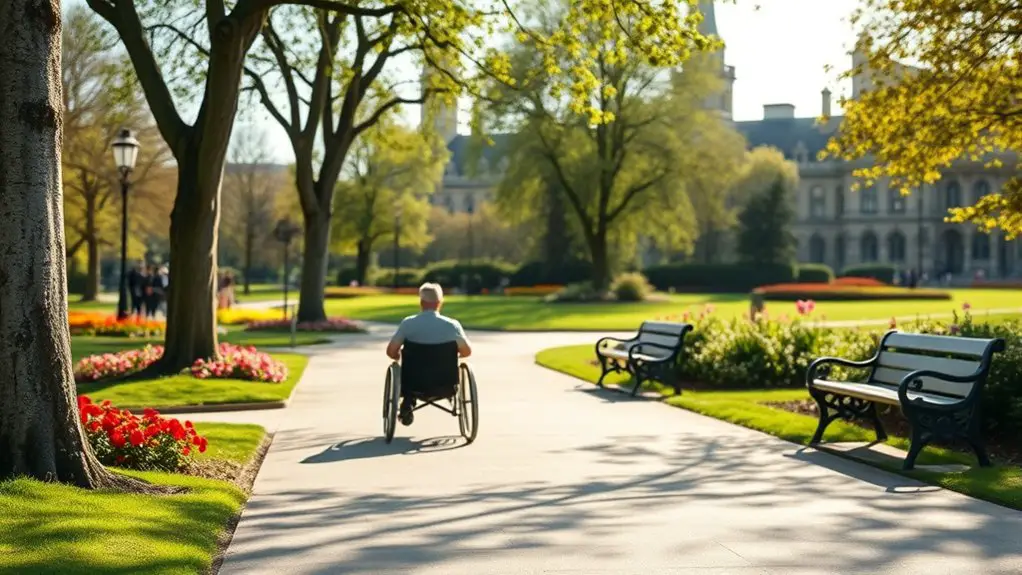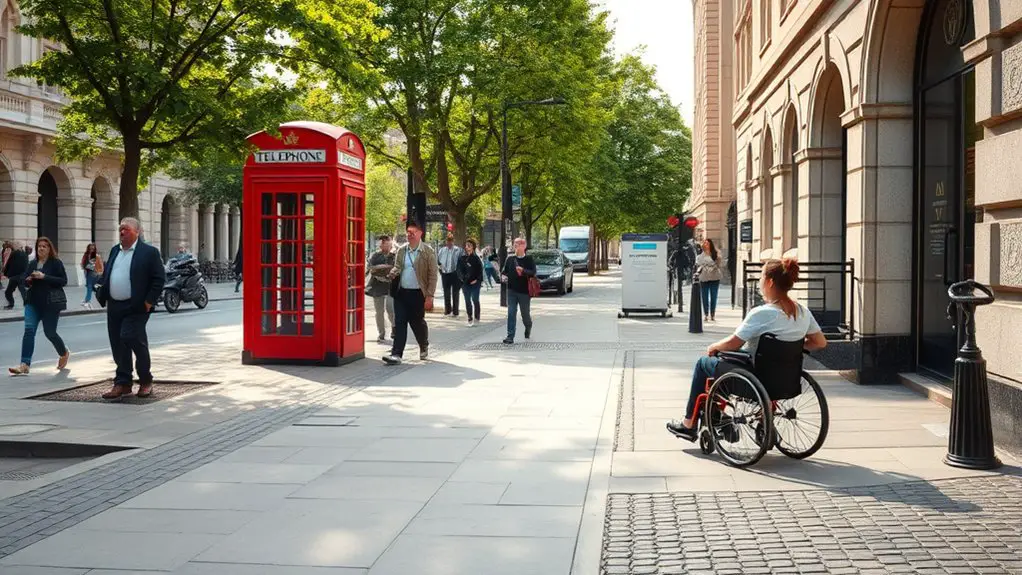If you’re searching for wheelchair accessible attractions in London, you’ll find a city rich with inclusive options. From iconic landmarks like the Tower of London and Buckingham Palace with ramps and lifts, to world-class museums such as the British Museum and Tate Modern, there are fully accessible galleries and exhibits. Enjoy green spaces like Hyde Park and Kew Gardens with smooth paths, plus entertainment venues with dedicated wheelchair seating. Keep exploring to discover detailed tips and how to make the most of your visit seamlessly.
Key Takeaways
- London’s iconic landmarks like Tower of London and Buckingham Palace offer ramps, lifts, and accessible entrances for visitors with mobility needs.
- Major museums such as the British Museum and Tate Modern provide detailed accessibility guides, assistive services, and tactile exhibits.
- Parks like Hyde Park and Kew Gardens feature wheelchair-friendly paths, smooth terrain, and accessible outdoor spaces.
- Public transportation options, including step-free Tube stations and accessible buses, facilitate easy travel across the city.
- Many entertainment venues and shopping districts, including Southbank Centre and Oxford Street, are equipped with accessible facilities and seating.
Iconic Landmarks With Accessibility Features
London’s iconic landmarks are more accessible than ever, ensuring everyone can enjoy their historic and architectural splendor. Many historic sites now feature accessible architecture, making navigation easier for visitors with mobility challenges.
At the Tower of London, ramps and lifts provide smooth access to key areas, allowing you to explore centuries of history comfortably. Buckingham Palace offers wheelchair-friendly routes, including accessible entrances and viewing areas for ceremonies and changing of the guard.
The Houses of Parliament have been modernized to include ramps and accessible toilets, so you can fully appreciate their grandeur without barriers. These enhancements highlight London’s commitment to inclusivity, enabling all visitors to admire its historic sites without frustration.
Whether marveling at the Gothic Revival architecture or delving into history, you’ll find that London’s landmarks now blend breathtaking design with thoughtful accessibility features, making them welcoming for everyone.
Top Museums and Cultural Venues

Museums and cultural venues in the city have prioritized accessibility, ensuring that everyone can explore their rich collections and vibrant exhibitions with ease. Many venues adhere to strict accessibility standards, making navigation simple for wheelchair users. You’ll find wide doorways, ramps, and elevators that provide seamless access to renowned museum highlights.
Notable examples include the British Museum, which offers detailed accessibility guides and assistive services, and the Tate Modern, with its fully accessible galleries and tactile exhibits. The Science Museum features accessible entrances and sensory-friendly hours, while the Victoria and Albert Museum provides accessible rest areas and dedicated support staff.
The British Museum, Tate Modern, Science Museum, and Victoria and Albert Museum all offer extensive accessibility services.
The Design Museum also champions inclusive design, ensuring that all visitors can enjoy their innovative displays. These efforts reflect a city committed to making its cultural treasures available to everyone, highlighting the importance of inclusive experiences in London’s thriving arts scene.
- British Museum’s accessible entrances and exhibits
- Tate Modern’s fully accessible galleries
- Science Museum’s sensory-friendly hours
- Victoria and Albert Museum’s support services
- Design Museum’s inclusive design initiatives
Green Spaces and Parks for All

Accessible green spaces and parks in London invite everyone to enjoy the city’s natural beauty, regardless of mobility challenges. Many parks feature accessible gardens filled with vibrant blooms and peaceful settings, perfect for relaxing strolls. Wheelchair-friendly trails wind through lush landscapes, allowing you to explore without barriers. These spaces prioritize inclusivity, ensuring all visitors can connect with nature comfortably.
| Park Name | Key Features |
|---|---|
| Hyde Park | Wide, smooth paths; accessible gardens |
| Regent’s Park | Wheelchair-friendly trails; serene lakes |
| Kew Gardens | Fully accessible gardens; gentle paths |
Whether you seek quiet reflection or scenic views, these parks provide a welcoming environment. They demonstrate London’s commitment to inclusive outdoor experiences, making it easy for you to enjoy the city’s green spaces fully.
Entertainment and Shopping Destinations
From peaceful green spaces to lively streets, London offers a vibrant array of entertainment and shopping options designed to welcome everyone. You can enjoy accessible theaters that feature wheelchair-friendly seating and assistive services, ensuring a comfortable experience.
Major shopping districts like Oxford Street and Covent Garden boast wheelchair-friendly shops with wide aisles and accessible entrances, making browsing easy. Museums such as the Victoria and Albert Museum provide engaging exhibitions and have accessible facilities to accommodate visitors with mobility needs.
For a lively atmosphere, explore Southbank Centre, which hosts performances and events in accessible venues. Additionally, many markets, including Borough Market, offer accessible paths and facilities, so you can indulge in local flavors and crafts with ease.
London’s commitment to accessibility means you won’t miss out on the city’s vibrant entertainment and shopping scene, ensuring a memorable experience for everyone.
Tips for Navigating London in a Wheelchair
Maneuvering London in a wheelchair can be both enjoyable and manageable with some planning.
Start by researching accessible public transport options like the Tube’s step-free stations, buses, and riverboats, which make travel smoother. Always check the Transport for London (TfL) website for real-time updates on accessibility features and service disruptions.
When choosing accommodations, prioritize accessible accommodations that offer wide doorways, roll-in showers, and elevators. Booking early guarantees you secure places equipped to meet your needs.
Use apps and maps designed for wheelchair users to navigate city streets efficiently, highlighting smooth sidewalks and curb cuts. During your trip, plan your routes around areas with accessible entrances and avoid crowded or uneven pavements.
Familiarize yourself with nearby accessible restrooms and facilities. With a bit of preparation, you’ll find London’s vibrant attractions and hidden gems easily accessible, making your visit both comfortable and memorable.
Frequently Asked Questions
Are There Wheelchair Rental Services Available Across London?
Yes, you can find wheelchair rental services throughout London, making exploring the city easier.
Many companies offer daily or hourly wheelchair rental options, so you can choose what suits your needs. These services typically include access fees that cover delivery and pick-up, ensuring convenience.
Renting a wheelchair allows you to enjoy London’s attractions comfortably and independently, with many providers offering accessible customer support to assist with your needs.
Which Public Transportation Options Are Most Accessible for Wheelchair Users?
You’ll find that accessible buses in London feature low floors and ramps, making wheelchair access straightforward.
The Tube also offers accessible options with step-free entrances, lifts, and dedicated spaces on many trains.
Transport for London continuously improves station accessibility, so traversing the city becomes easier for wheelchair users.
Combining accessible buses and Tube services guarantees you can travel comfortably and independently across London’s vibrant streets and iconic sights.
Are Guided Tours Available Specifically for Wheelchair Users?
Yes, there are accessible tour options and guided tour services specifically designed for wheelchair users in London.
Many companies offer tailored guided tours that include accessible transportation and accommodations, allowing you to explore iconic sights comfortably.
These accessible tour options guarantee you enjoy a thorough experience without barriers, with knowledgeable guides who cater to your needs.
Book in advance to confirm availability and customize your tour to make the most of your visit.
How Accessible Are London’s Historic Sites and Their Facilities?
London’s historic sites offer varying levels of accessibility, with many providing ramps, lifts, and accessible facilities to enhance your visitor experience.
You’ll find that some sites, like the Tower of London and Westminster Abbey, have made significant improvements, but others may still have limited access.
Your feedback is essential, as it helps sites improve. Always check in advance, and you’ll enjoy a memorable visit, knowing your needs are considered.
What Are the Best Resources for Emergency Assistance in Accessible Locations?
You should always carry emergency contacts and familiarize yourself with safety procedures for accessible locations in London.
Keep a mobile phone handy, saved with local emergency numbers like 999, and ask staff about specific safety protocols.
Many attractions provide clear signage and staff trained in accessibility emergencies.
Additionally, consider downloading local emergency apps or accessibility guides, ensuring you’re prepared for any situation and can get prompt assistance when needed.
Conclusion
Exploring London in a wheelchair is truly rewarding with its many accessible attractions. From iconic landmarks to lush parks and vibrant cultural venues, the city welcomes everyone. With a little planning and the right information, you can enjoy unforgettable experiences and discover all the city has to offer. So, go ahead, embrace the adventure, and make the most of your visit—London’s diverse accessibility features guarantee your journey is smooth, enjoyable, and full of memorable moments.
